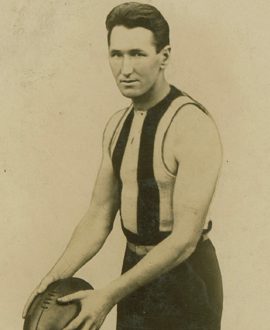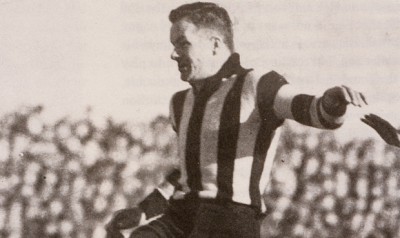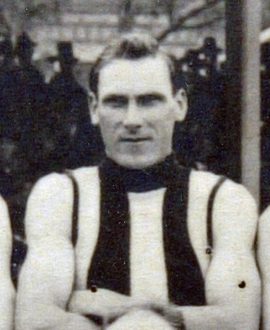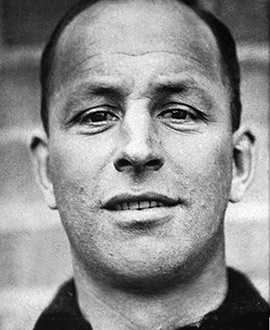In modern terminology, Syd Coventry represents Collingwood's greatest ever 'triple threat'. As a player he had few superiors in the game. As a captain he was arguably the club's best ever. And as a president he took over and managed to heal a club that had been torn apart by internal bloodletting.
He played for 13 years, won the Brownlow Medal and two Copeland Trophies, and was named Collingwood's best player in at least one other season. He led the club to four successive Premierships in his first four years as captain, and was also first-choice skipper of the Victorian side for many years (the Vics never lost under his leadership). He then capped off his involvement by spending 11 years as a vice-president and a further 13 as president. And through it all he remained calm, composed, dignified, and one of the most widely respected men in football.
It's an impressive body of work – one which firmly stamps Syd Coventry as one of the giants of the Collingwood Football Club.
Syd's footballing story started with Diamond Creek when he was 13. As many as six the Coventry boys played with the team at the same time, including Syd's famous goalkicking younger brother Gordon, but both Gordon and Syd were convinced that the best of the bunch was another brother, Norman, who was killed in the First World War.
The Coventry boys worked in the mines around Diamond Creek, and while Gordon started making his way at Collingwood Syd spent some time working the mines in Tasmania. But he was still on the radar of a handful of VFL clubs, and signed to play with St Kilda when he came back to Melbourne. By the time he did so, however, he was having second thoughts: firstly he wanted to play with Gordon, and secondly he realised it was a bloody long way from Diamond Creek to St Kilda.
So Syd reneged on his contract with the Saints, meaning he had to sit out of football for a year. In the end, he couldn't start his career in the black and white jumper until 1922.
But boy, did he make up for lost time. He settled into his league career much more quickly than Gordon had, and before long was winning rave reviews for his work as a ruckman/defender/follower. He stood about 180cm tall, weighed in around 86kg and had the perfect physique for ruck play, being immensely strong but still mobile. He loved the physical side of the game and would regularly throw himself into the most fearsome crushes with abandon. As the Sporting Globe noted in 1927: “Syd seems to be electrical in his movements and a mass of energy, unsparingly throwing himself into the vigorous ruck work. Those strong shoulders of his are never idle, and he literally forges his way through anything. He takes some terribly hard knocks, but gives them back equally hard”.
He was a magnificent high mark, with a good spring and splendid anticipation. When the ball hit the ground he was not lost either, and was seldom beaten by other followers in a race for the ball. He was a long drop or punt kick, and was described as having “the kicking power of a healthy horse”. He wasn't too big on handball or short passes: whenever he got the ball he tended to boot it as far as possible.
Syd was also an exceptionally smart footballer. He often had to carry the Collingwood ruck almost single-handedly, and he learned to perfect the art of playing a kick behind the play. He would rarely venture beyond the centre and would regularly rack up possessions through his astute positioning and reading of the play. Another big punt kick and the ball would be back deep in the Magpie forward line.
Those footy smarts really came to the fore in the second phase of Syd's career, when he was named Collingwood's captain. The appointment came in controversial circumstances, when Charlie Tyson was dumped just days before the start of the 1927 season, but the controversy was quickly forgotten as Syd had his best ever season, not only winning the Brownlow Medal and the first ever Copeland Trophy but also impressing everyone with his leadership.
"Syd is the all-round menace whose shrewd direction from all parts of the playground has often brought victory to the Magpies in the last few minutes of a winter afternoon," wrote Table Talkmagazine in 1927. "He has won matches time and again by his tactical aplomb at critical moments. To the Collingwood Football Club, Syd Coventry is an ideal mixture of Napoleon and Nelson, with a dash of Caesar and Alexander the Great."
Brother Gordon had always seen these qualities in Syd, saying that he seemed “born to lead” in football. Certainly, no man did more as a player and a leader to inspire those Magpie teams. His determination, fearlessness and will-to-win frequently lifted the team to greater heights, and his in-game acumen turned many a contest. “A few words from him, if we were not shaping like winners, usually had the desired effect,” said one former teammate.
Syd was a highly marketable footballer, advertising shorts and boots that carried his name, and even a tonic to cure boils! But his exalted standing in the game owed as much to his exceptional personal qualities as it did to his abilities as both a player and a captain. He was warm and kind, admired and loved by colleagues and opponents alike. He had a delightful sense of humour and was regarded by most of his former colleagues as a great man. He was also ridiculously modest, as Table Talknoted in 1927: "Adoration by the broadside never stirs his phlegm: the worship of a million plevendors would be nothing to him. Even when sweet ladies scream his triumph from the stands and fences there is not a trace of pink in his marble brow."
The tributes upon his retirement from the playing fields were as fulsome as they were warranted.
"He has been the idol of the football-loving public of Collingwood," wrote theAustralasian. "He has been to the local football club what Jack Ryder has been to the cricket club – an inspiration to those under his command. His motto was manliness and sportsmanship, and he retires with everybody's good will." Table Talkagreed: "Syd Coventry commands respect because of his even temper, his general sportsmanship and his fine rearguard courage in many a gloomy scene… he is the epitome of the athlete as the average Australian admires him."
The Argustribute ran along similar lines: "The game has had many champions, many fine sportsmen, but none has shed greater lustre on the sport than this man from Diamond Creek, who at the age of 35 years leaves the game he has adorned with the knowledge that he is admired and respected by all who take an interest in football."
After his retirement, Syd spent an unhappy and largely unsuccessful couple of years as coach at Footscray (a club he had tried to cross to several times earlier), before coming 'home' to Victoria Park and taking up a vice-presidential role in 1939.
In 1950, the club was thrown into tumult following the committee's short-lived and ill-advised decision to appoint Bervin Woods to replace Jock McHale as coach. A full-scale revolt followed which saw long-serving stalwarts Bob Rush (treasurer), Frank Wraith (secretary) and Harry Curtis (president) all forced out, and the club torn apart by internal fighting. Once more Syd stood up for his beloved Magpies by agreeing to become president. In what has become an often-underestimated part of the Syd Coventry story, he used all his personal skills and good standing to help bring the club together after one of the nastiest episodes in its history. It's debatable whether anybody else stepping into that position at that time could have turned things around so quickly.
Two flags followed during his time as president. But just as importantly there was huge growth in both the operations of the Social Club and the development of Victoria Park. By the time he retired from the post early in 1963, the club was in excellent shape off the field.
That ended Syd Coventry's official career at Collingwood. But his name and legacy endure to this day, as a byword for what it means to be a 'great Collingwood person'. He was, and always will be, one of the true icons of the Collingwood Football Club.
- Michael Roberts





